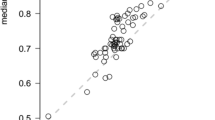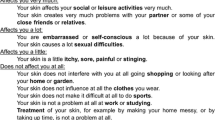Abstract
Objective
In many jurisdictions, deterioration in quality of life assessed with Dermatology Life Quality Index (DLQI) is used for medical and reimbursement decisions in various dermatological conditions such as psoriasis. However, utility values for health states defined by the DLQI have not yet been evaluated. Therefore, we aim to estimate utilities for different health states described by the ten items of the DLQI.
Methods
A cross-sectional survey was performed in a convenience sample of the general population. Seven DLQI health states with total scores of 6, 11 and 16 (3–3 and 1 states, respectively) were developed. All of them were different from each other in the number of affected items and severity levels of impairment. The 10-year time trade-off method was used to value health states.
Results
Mean utilities elicited by the respondents (n = 308) for the three 6-, three 11- and one 16-point DLQI health states were 0.62–0.75, 0.59–0.66, and 0.56, respectively. In half of the six pairwise comparisons, where health states with the same total DLQI score were compared, significant difference between utilities was found. In eight out of the 15 comparisons between health states with different DLQI scores, utilities were not significantly different.
Conclusions
Utility values for health states with identical DLQI total score may significantly vary. This result might be generalisable to various patient populations, in which the DLQI is used; nevertheless, further research is needed. The discrepancies between DLQI scores and utilities might have an impact on medical and reimbursement decisions as they make the utility gain from treatment uncertain.

Similar content being viewed by others
References
Finlay, A. Y., & Khan, G. K. (1994). Dermatology Life Quality Index (DLQI): A simple practical measure for routine clinical use. Clinical and Experimental Dermatology, 19(3), 210–216.
Basra, M. K., Fenech, R., Gatt, R. M., Salek, M. S., & Finlay, A. Y. (2008). The Dermatology Life Quality Index 1994–2007: A comprehensive review of validation data and clinical results. British Journal of Dermatology, 159(5), 997–1035. doi:10.1111/j.1365-2133.2008.08832.x.
European Medicines Agency. Guideline on clinical investigation of medicinal products indicated for the treatment of psoriasis. London, 18 November 2004. http://www.ema.europa.eu/docs/en_GB/document_library/Scientific_guideline/2009/09/WC500003329.pdf. Accessed: 02 July 2015.
Mrowietz, U., Kragballe, K., Reich, K., Spuls, P., Griffiths, C. E., Nast, A., et al. (2011). Definition of treatment goals for moderate to severe psoriasis: a European consensus. Archives of Dermatological Research, 303(1), 1–10. doi:10.1007/s00403-010-1080-1.
Pathirana, D., Ormerod, A. D., Saiag, P., Smith, C., Spuls, P. I., Nast, A., et al. (2009). European S3-guidelines on the systemic treatment of psoriasis vulgaris. Journal of the European Academy of Dermatology and Venereology, 23(Suppl 2), 1–70. doi:10.1111/j.1468-3083.2009.03389.x.
Hagg, D., Sundstrom, A., Eriksson, M., & Schmitt-Egenolf, M. (2015). Decision for biological treatment in real life is more strongly associated with the Psoriasis Area and Severity Index (PASI) than with the Dermatology Life Quality Index (DLQI). Journal of the European Academy of Dermatology and Venereology, 29(3), 452–456. doi:10.1111/jdv.12576.
Wakkee, M., Thio, H. B., Spuls, P. I., de Jong, E. M., & Nijsten, T. (2008). Evaluation of the reimbursement criteria for biological therapies for psoriasis in the Netherlands. British Journal of Dermatology, 158(5), 1159–1161. doi:10.1111/j.1365-2133.2008.08512.x.
Rencz, F., Kemény, L., Gajdácsi, J. Z., Owczarek, W., Arenberger, P., Tiplica, G. S., et al. (2015). Use of biologics for psoriasis in Central and Eastern European countries. Journal of the European Academy of Dermatology and Venereology, 29(11), 2222–2230.
Basra, M. K., Chowdhury, M. M., Smith, E. V., Freemantle, N., & Piguet, V. (2012). Quality of life in psoriasis and chronic hand eczema: The discrepancy in the definition of severity in NICE guidelines and its implications. British Journal of Dermatology, 166(2), 462–463. doi:10.1111/j.1365-2133.2011.10601.x.
Finlay, A. Y., Basra, M. K., Piguet, V., & Salek, M. S. (2012). Dermatology life quality index (DLQI): A paradigm shift to patient-centered outcomes. Journal of Investigative Dermatology, 132(10), 2464–2465. doi:10.1038/jid.2012.147.
Mazzotti, E., Barbaranelli, C., Picardi, A., Abeni, D., & Pasquini, P. (2005). Psychometric properties of the Dermatology Life Quality Index (DLQI) in 900 Italian patients with psoriasis. Journal of Investigative Dermatology, 85(5), 409–413. doi:10.1080/00015550510032832.
Nijsten, T. (2012). Dermatology life quality index: Time to move forward. Journal of Investigative Dermatology, 132(1), 11–13. doi:10.1038/jid.2011.354.
Nijsten, T., Meads, D. M., de Korte, J., Sampogna, F., Gelfand, J. M., Ongenae, K., et al. (2007). Cross-cultural inequivalence of dermatology-specific health-related quality of life instruments in psoriasis patients. Journal of Investigative Dermatology, 127(10), 2315–2322. doi:10.1038/sj.jid.5700875.
Nijsten, T., Meads, D. M., & McKenna, S. P. (2006). Dimensionality of the dermatology life quality index (DLQI): A commentary. Acta Derm Venereol, 86(3), 284–285; author reply 285–286. doi:10.2340/00015555-0075.
Twiss, J., Meads, D. M., Preston, E. P., Crawford, S. R., & McKenna, S. P. (2012). Can we rely on the Dermatology Life Quality Index as a measure of the impact of psoriasis or atopic dermatitis? Journal of Investigative Dermatology, 132(1), 76–84. doi:10.1038/jid.2011.238.
Hongbo, Y., Thomas, C. L., Harrison, M. A., Salek, M. S., & Finlay, A. Y. (2005). Translating the science of quality of life into practice: What do dermatology life quality index scores mean? Journal of Investigative Dermatology, 125(4), 659–664. doi:10.1111/j.0022-202X.2005.23621.x.
Basra, M. K., Salek, M. S., Camilleri, L., Sturkey, R., & Finlay, A. Y. (2015). Determining the minimal clinically important difference and responsiveness of the Dermatology Life Quality Index (DLQI): Further data. Dermatology, 230(1), 27–33. doi:10.1159/000365390.
Stalmeier, P. F., Goldstein, M. K., Holmes, A. M., Lenert, L., Miyamoto, J., Stiggelbout, A. M., et al. (2001). What should be reported in a methods section on utility assessment? Medical Decision Making, 21(3), 200–207.
Canadian Agency for Drugs and Technologies in Health. (2006). Guidelines for the economic evaluation of health technologies. https://www.cadth.ca/media/pdf/186_EconomicGuidelines_e.pdf. Accessed 25 June 2015.
National Institute for Health and Care Excellence (NICE). (2013). Guide to the methods of technology appraisal. http://www.nice.org.uk/article/pmg9/resources/non-guidance-guide-to-the-methods-of-technology-appraisal-2013-pdf. Accessed 23 June 2015.
Siegel, J. E., Torrance, G. W., Russell, L. B., Luce, B. R., Weinstein, M. C., & Gold, M. R. (1997). Guidelines for pharmacoeconomic studies. Recommendations from the panel on cost effectiveness in health and medicine. Panel on cost Effectiveness in Health and Medicine. Pharmacoeconomics, 11(2), 159–168.
Kharroubi, S. A., Brazier, J. E., & Yang, Y. (2014). Modeling a preference-based index for two condition-specific measures (asthma and overactive bladder) using a nonparametric Bayesian method. Value Health, 17(4), 406–415. doi:10.1016/j.jval.2014.05.002.
Lloyd, A., Kerr, C., Breheny, K., Brazier, J., Ortiz, A., & Borg, E. (2014). Economic evaluation in short bowel syndrome (SBS): An algorithm to estimate utility scores for a patient-reported SBS-specific quality of life scale (SBS-QoL). Quality of Life Research, 23(2), 449–458. doi:10.1007/s11136-013-0516-4.
Mukuria, C., Rowen, D., Brazier, J. E., Young, T. A., & Nafees, B. (2015). Deriving a preference-based measure for myelofibrosis from the EORTC QLQ-C30 and the MF-SAF. Value Health, 18(6), 846–855. doi:10.1016/j.jval.2015.07.004.
Rowen, D., Mulhern, B., Banerjee, S., Hout, B., Young, T. A., Knapp, M., et al. (2012). Estimating preference-based single index measures for dementia using DEMQOL and DEMQOL-Proxy. Value Health, 15(2), 346–356. doi:10.1016/j.jval.2011.10.016.
Dolan, P. (1997). Modeling valuations for EuroQol health states. Medical Care, 35(11), 1095–1108.
Gudex, C. (1994). Time trade-off user manual: Props and self-completion methods. York: Report of the Centre for Health Economics. University of York.
Chen, S. C., Bayoumi, A. M., Soon, S. L., Aftergut, K., Cruz, P., Sexton, S. A., et al. (2004). A catalog of dermatology utilities: a measure of the burden of skin diseases. Journal of Investigative Dermatology Symposium Proceedings, 9(2), 160–168. doi:10.1046/j.1087-0024.2003.09112.x.
Hernandez Alava, M., Wailoo, A. J., & Ara, R. (2012). Tails from the peak district: adjusted limited dependent variable mixture models of EQ-5D questionnaire health state utility values. Value Health, 15(3), 550–561. doi:10.1016/j.jval.2011.12.014.
Lehman, E. (2007). Nonparametrics: Statistical methods based on ranks. New York: Springer.
Burstrom, K., Johannesson, M., & Diderichsen, F. (2006). A comparison of individual and social time trade-off values for health states in the general population. Health Policy, 76(3), 359–370. doi:10.1016/j.healthpol.2005.06.011.
Dolan, P. (1999). Whose preferences count? Medical Decision Making, 19(4), 482–486.
Ubel, P. A., Loewenstein, G., & Jepson, C. (2003). Whose quality of life? A commentary exploring discrepancies between health state evaluations of patients and the general public. Quality of Life Research, 12(6), 599–607.
Acknowledgments
The authors are grateful to Mrs. Vivien Papp-Surányi, an undergraduate student at the Faculty of Economics, Corvinus University of Budapest, for her assistance in carrying out the web survey.
Author information
Authors and Affiliations
Corresponding author
Ethics declarations
Conflict of interest
The authors declare that they have no conflict of interest.
Ethical standard
Ethical approval was obtained from Semmelweis University Regional and Institutional Committee of Science and Research Ethics (Reference No. 58./2015).
Human and animal rights
All procedures performed in studies involving human participants were in accordance with the ethical standards of the institutional and/or national research committee and with the 1964 Helsinki declaration and its later amendments or comparable ethical standards.
Informed consent
Informed consent was obtained from all individual participants included in the study.
Appendix: Example TTO task
Appendix: Example TTO task

Rights and permissions
About this article
Cite this article
Rencz, F., Baji, P., Gulácsi, L. et al. Discrepancies between the Dermatology Life Quality Index and utility scores. Qual Life Res 25, 1687–1696 (2016). https://doi.org/10.1007/s11136-015-1208-z
Accepted:
Published:
Issue Date:
DOI: https://doi.org/10.1007/s11136-015-1208-z




